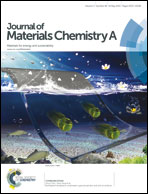Porous Li4Ti5O12–TiO2 nanosheet arrays for high-performance lithium-ion batteries†
Abstract
This work reports on porous Li4Ti5O12 (LTO)–TiO2 nanosheet arrays prepared via a versatile hydrothermal method for lithium ion batteries, exhibiting a high initial discharge capacity of 184.6 mA h g−1 at 200 mA g−1 and possessing excellent electrochemical stability with only 8.3% loss of specific capacity at 1 A g−1 in a prolonged charge–discharge process (1000 cycles). The excellent electrochemical performance can be attributed to the interconnected mesoporous/macroporous structures and the abundant grain boundaries generated by the existing multiphase materials, as well as the direct connection between the nanoarrays and conductive Ti substrates which facilitates the lithium ion and electron transportation. A flexible lithium ion battery has been further designed by using the nanosheet LTO–TiO2 arrays as the anode and LiCoO2 as the cathode, enabling it to reliably power an LED light under severe mechanical bending. This is very promising for future potential application in high performance flexible energy storage devices.



 Please wait while we load your content...
Please wait while we load your content...